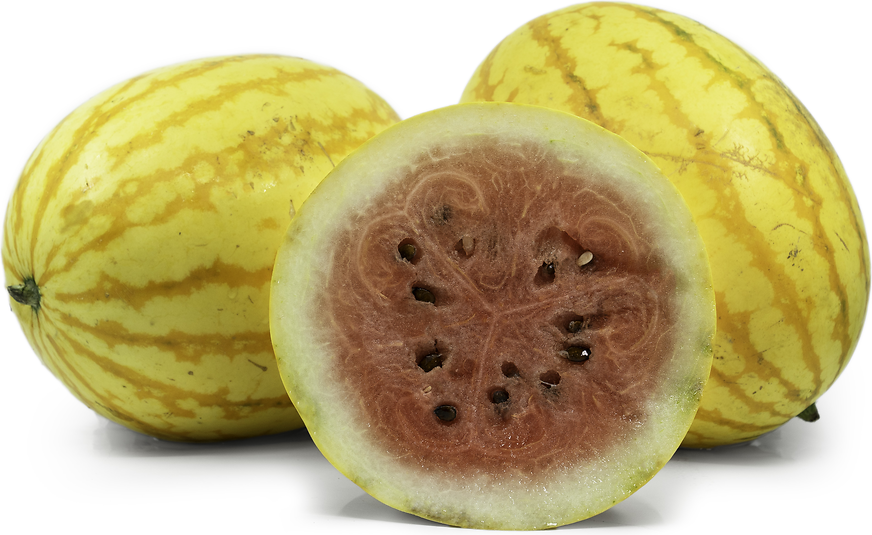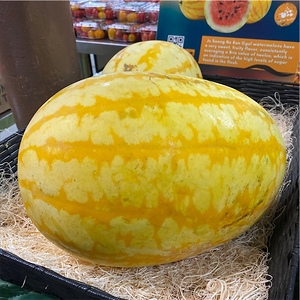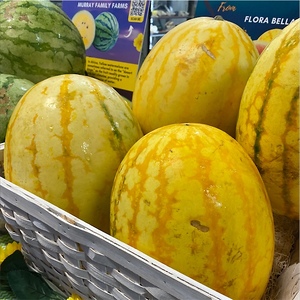


Jo Saeng No Ran Ggul Watermelons
Estimated Inventory, ea : 0
Description/Taste
Jo Saeng No Ran Ggul watermelons are small, oval to round fruits, averaging 15 to 25 centimeters in diameter, and typically weigh between 6 to 9 pounds. The rind is smooth, firm, semi-thick, and pale yellow, covered in variegated dark yellow striping and mottling. Underneath the rind, the dense and solid flesh is dark red with an aqueous, crisp, and tender consistency. The flesh also encases many oval and flat, black seeds. Jo Saeng No Ran Ggul watermelons have a very sweet, fruity flavor, consistently averaging a Brix value of twelve, which is an indication of the high levels of sugar found in the flesh.
Seasons/Availability
Jo Saeng No Ran Ggul watermelons are available in the summer.
Current Facts
Jo Saeng No Ran Ggul watermelons, botanically classified as Citrus lanatus, are a rare, tiger-striped variety belonging to the Cucurbitaceae family. The golden watermelon has origins in Asia and has become a specialty variety cultivated in the United States for its unusual coloring and sweet flavor. Jo Saeng No Ran Ggul watermelons are not commercially produced and are grown through select farms for sale at local farm stands and markets. The variety is also frequently purchased through online seed retailers for home garden use and is favored by growers for their small size, compact vines, quality flavor, and early ripening. Jo Saeng No Ran Ggul watermelons can be harvested approximately 75 to 80 days after planting and are considered to be an easy-to-grow variety.
Nutritional Value
Jo Saeng No Ran Ggul watermelons are an excellent source of lycopene, which is an antioxidant that gives the flesh its red hue and helps to reduce inflammation within the body. The small watermelons are also an excellent source of vitamins A and C, which are antioxidants that can strengthen the immune system and promote collagen production within the skin.
Applications
Jo Saeng No Ran Ggul watermelons are best suited for raw applications as their sweet, juicy flesh is showcased when consumed straight, out-of-hand. The distinct color contrast between the rind and flesh is also highlighted when sliced and eaten fresh. The flesh can be cubed, cut, or balled and tossed into fruit bowls and green salads, chopped into salsa, or used as a topping over yogurt, cereal, and ice cream. The flesh can also be blended into smoothies, juiced, or used to flavor summer-inspired cocktails. In Korea, watermelons are frequently used to make subak hwachae, which is a traditional fruit punch enjoyed in the summer. There are many variations of the punch, made with various fruits, and primary ingredients include soda, honey, sugar, milk, and watermelon. Jo Saeng No Ran Ggul watermelons pair well with other fruits such as coconut, berries, and citrus, balsamic vinegar, mint, arugula, parmesan, feta, and pistachios. The small watermelons store well and can be kept whole at room temperature for 7 to 10 days or refrigerated for 2 to 3 weeks. Once sliced, the cut watermelon can be stored in the refrigerator in a sealed container for up to five days. The flesh can also be frozen up to one year.
Ethnic/Cultural Info
Jo Saeng No Ran Ggul watermelons are considered to be an icebox variety, which is a term to describe watermelons that are small enough to fit in a refrigerator. Icebox watermelons have been cultivated since the mid-20th century and are favored by consumers for their compact nature, sweet flavor, and longer shelf life. In addition to consumer preference, growers are turning to icebox varieties as the watermelons are early maturing, fairly resistant to diseases, and can be grown in a smaller space, allowing more plants to be sown. Jo Saeng No Ran Ggul watermelons were tested among other icebox varieties at the Mount Vernon Northwestern Washington Research and Extension Center in 2016 and were ranked as one of the sweetest tasting varieties.
Geography/History
Jo Saeng No Ran Ggul watermelons are believed to be native to Korea, but the exact history and parentage remain unknown. The seeds of the yellow-skinned watermelon are imported in small quantities, approximately one hundred seeds or less, from Korea to the United States through Osborne Quality Seeds. The Washington State-based company gathers unique and rare varieties from all over the world and trials the seeds to determine whether they can successfully thrive in different climates. Once approved, the seeds are sold to growers and home gardeners. Osborne Quality Seeds have been selling Jo Saeng No Ran Ggul watermelon seeds since the early 21st century and have growers cultivating the watermelons in regions across the continental United States.









